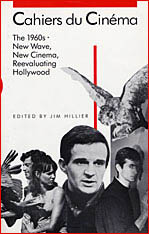Cahiers du Cinéma, one of the most influential film journals ever published, has been a pioneer in the formation and transformation of contemporary film theory. This new volume presents the major writings published in Cahiers from 1969 to 1972, the period of its intensive elaboration of a materialist account of the history, theory, and criticism of cinema. In the context of the radically charged social and intellectual movements of post-1968 France, the character of the journal and its contributors changed. The artists and filmmakers who had dominated Cahiers in its earlier years were succeeded by a generation of theorists, who drew upon structuralism, psychoanalysis, semiotics, literary study, and Marxism to construct an ideological critique of film’s relation to society.
Their writings had an enormous impact on film theory in Britain and the United States, but the primary documents for the most part have not been available in English. By bringing together the major articles from this decisive period and putting them in their historical context, the present volume provides materials for understanding the evolution of film theory in the 1970s and after. This anthology—sponsored and translated by the British Film Institute—will be an essential reference work for students and teachers of film, communications, critical theory, and cultural studies.

In the turbulent sixties, the provocative French film journal Cahiers du Cinéma was at its most influential and controversial. The first successes of the New Wave by major Cahiers contributors such as Jean-Luc Godard, François Truffaut, Jacques Rivette, Eric Rohmer, and Claude Chabrol focused international attention on the revitalization of French cinema and its relation to film criticism; and in the early 1960s the journal’s laudatory critiques of popular American movies were attaining the greatest notoriety.
As the lively articles, interviews, and polemical discussions in this volume reveal, the 1960s saw the beginnings of significant new directions in filmmaking and film criticism changes in which the New Wave itself was a major factor. The auteur theory that the journal had championed in the 1950s began to be rethought and revalued. At the same time, along with a reassessment of American film, Cahiers began to embrace new, often oppositional forms of cinema and criticism, culminating in the political and aesthetic radicalism of the ensuing decade.
The selections, translated under the supervision of the British Film Institute, are annotated by Jim Hillier, and context is provided in his general introduction and part introductions. For an understanding of the important changes that took place in cinema and film criticism in the 1960s and beyond, this book is essential reading.

Cahiers du Cinéma is the most prestigious and influential film journal ever published. An anthology devoted entirely to its writings, in English translation, is long overdue.
The selections in this volume are drawn from the colorful first decade of Cahiers, 1951–1959, when a group of young iconoclasts rocked the world of film criticism with their provocative views on international cinema—American, Italian, and French in particular. They challenged long-established Anglo-Saxon attitudes by championing American popular movies, addressing genres such as the Western and the thriller and the aesthetics of technological developments like CinemaScope, emphasizing mise en scène as much as thematic content, and assessing the work of individual filmmakers such as Hawks, Hitchcock, and Nicholas Ray in terms of a new theory of the director as author, auteur, a revolutionary concept at the time. Italian film, especially the work of Rossellini, prompted sharp debates about realism that helped shift the focus of critical discussion from content toward style. The critiques of French cinema have special interest because many of the journal’s major contributors and theorists—Godard, Truffaut, Rohmer, Rivette, Chabrol—were to become some of France’s most important film directors and leaders of the New Wave.
Translated under the supervision of the British Film Institute, the selections have for the most part never appeared in English until now. Jim Hillier has organized them into topical groupings and has provided introductions to the parts as well as the whole. Together these essays, reviews, discussions, and polemics reveal the central ideas of the Cahiers of the 1950s not as fixed doctrines but as provocative, productive, often contradictory contributions to crucial debates that were to overturn critical thinking about film.
READERS
Browse our collection.
PUBLISHERS
See BiblioVault's publisher services.
STUDENT SERVICES
Files for college accessibility offices.
UChicago Accessibility Resources
home | accessibility | search | about | contact us
BiblioVault ® 2001 - 2024
The University of Chicago Press









